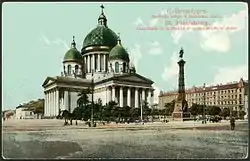Vasily Stasov
Vasily Petrovich Stasov (Russian: Васи́лий Петро́вич Ста́сов; 4 August 1769 – 5 September 1848) was a Russian architect.



Biography
Stasov was born in Moscow.
He extensively travelled in France and Italy, where he became professor at the St Luke Academy in Rome. On his return home, he was elected to the Imperial Academy of Arts (1811). One of his early works, the Gruzino estate near Novgorod, was built for Count Alexey Arakcheyev in the 1810s and was completely destroyed during World War II.
While developing guidelines for other architects, Stasov advocated making even the most trivial of buildings—barracks, storehouses, stables—look imposing and monumental. He worked much to embellish Tsarskoe Selo, where he designed the famous Pushkin Lyceum, the fanciful Chinese Village and also the Office of the Police Chief, which is an adaption of the project developed by the architect V. I. Geste. After the great fire of 1820, he was entrusted to remodel in the Neoclassical style some premises of the baroque Catherine Palace.
Stasov's first important commissions in the capital were the Transfiguration and the Trinity cathedrals for the regiments of the Russian Imperial Guard. The interior decoration of the Smolny Cathedral also belongs to him.
Stasov was the forerunner of the Russian Revival of the Nicholas I period, with his Alexander Nevsky Memorial Church in Potsdam (1826, complementing his Alexandrovka project) and a larger Church of the Tithes in Kiev (1828). The latter, a ponderous edifice with Byzantine and Russian features, was erected on the spot of the first church of Kievan Rus' and contained the relics of Saint Vladimir until its destruction by Bolsheviks in the 1930s.
During the reign of Nicholas I, Stasov designed Moscow Triumphal Gates and Narva Triumphal Gates in St Petersburg and the present-day Presidential Palace in Vilnius. In 1833, he was approached by the Siberian Cossacks who asked him to produce a large cathedral in Omsk. His last work of importance was the decoration of the Winter Palace halls after the disastrous fire of 1837.
He died in Saint Petersburg.
Other works
Family
His sons were:
- Vladimir Stasov (1824–1906), a Russian critic
- Dmitry Stasov (1828–1918), an advocate who took part in the foundation of the Russian Music Society